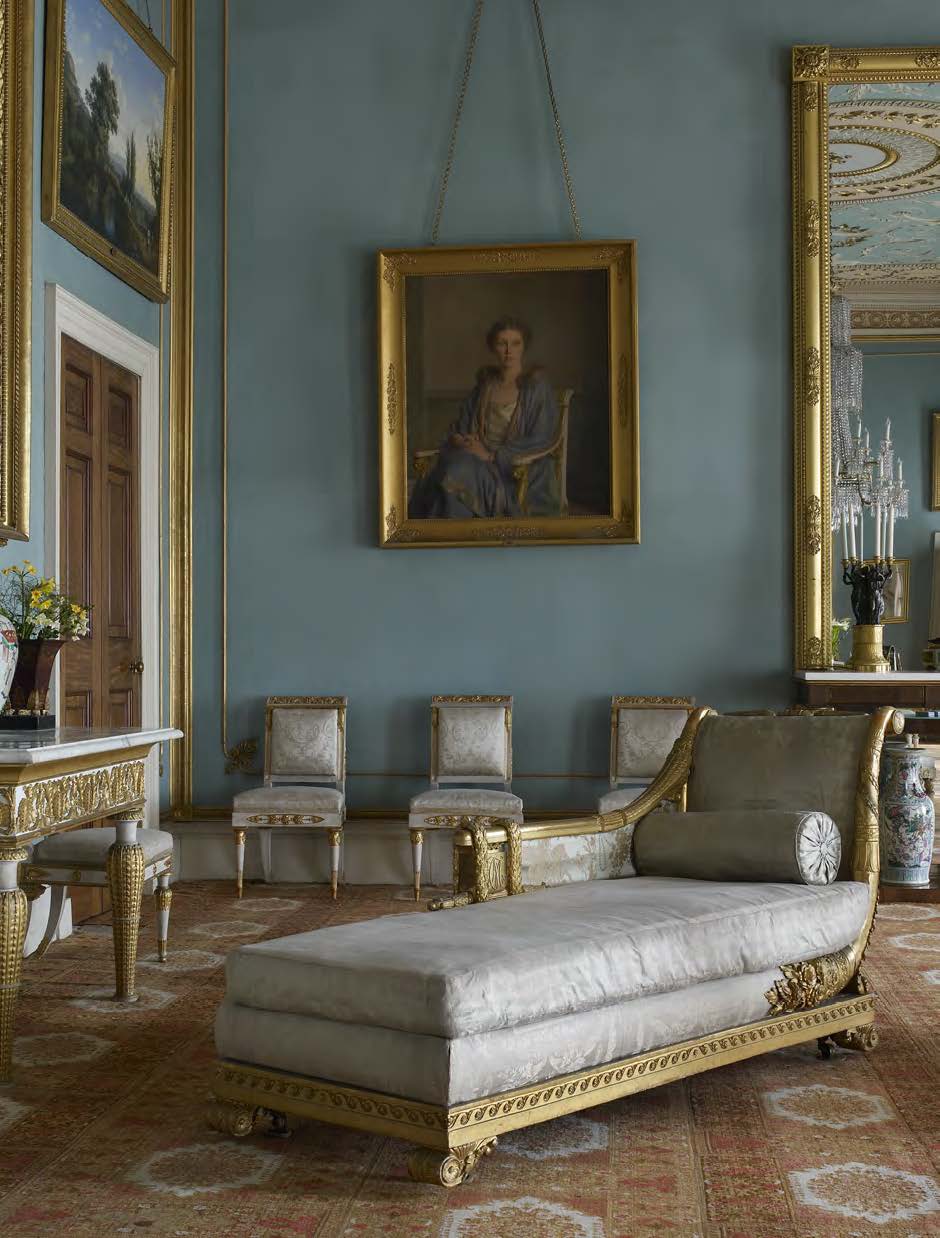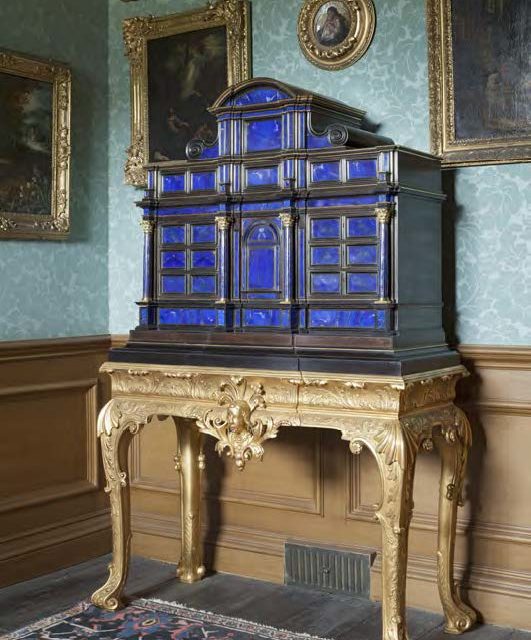The Furniture Research & Cataloguing Project was instigated in August 2015 by the Furniture Curator, Christopher Rowell, and Philip Claris, then Head of Collections Management, who appointed Dr Wolf Burchard as Furniture Research Curator. Generously supported by the Royal Oak Foundation and the Paul Mellon Centre for Studies in British Art, the project aimed to ‘improve… understanding and appreciation’ of the National Trust’s collection of approximately 50,000 pieces of furniture. Dedicated to the study of furniture alone, new cataloguing and research has already been published and will result in two major outcomes: a book, Furniture in National Trust Houses currently being written by Christopher, and enhanced entries on National Trust Collections for every single piece of furniture in Trust properties. The latter, a user-friendly version of the Collections Management System (CMS) and accessible by anyone online, provides a ‘fascinating and extremely useful resource for specialists and the general public all over the world’.1
Applying due diligence

The Drawing Room at Attingham Park, Shropshire © National Trust Images/Paul Barker
In autumn 2015, the project had ‘enhanced’ 4,000 records in eight properties; by spring 2019, just over 21,000 furniture records in over 60 Trust properties had been updated and the project has evolved considerably, both in its methodology and in its scope. Initially, and thanks to the photographs attached to (most) records on CMS, Philip planned for catalogers to survey most of the furniture remotely. This virtual approach to surveying was, of course, supplemented by research into a property and its collections, and by reading material published by art and furniture historians in the years following an object’s original appearance on CMS. It soon became apparent, however, that the cataloguers, all with a background in inspecting furniture before cataloguing it, could only properly enhance the records if every piece was physically examined.
We now, therefore, begin by researching the history of a chosen property and its collection, establishing what archival material is available and relevant. Only then do we visit a property, typically examining between 70 and 100 pieces of furniture a day. Back in the office, we begin our work on CMS, not only providing a brief description of the object and its physical characteristics, but also new details of both primary and secondary materials, creation dates, details of makers, origins and marks. We consult inventories and other sources, such as bills and receipts, to record as much of an object’s provenance as possible. All three cataloguers (Simon Green, James Weedon and I) work to standards set out in the Furniture Cataloguing Manual, and so the ‘enhanced’ entries are not only fuller but more consistent. We also apply an importance or significance ranking to each record, to assist properties to decide, for instance, what should be conserved, or displayed, or what might benefit from further research.
To add value to the information on CMS, we draw our work together in a final report, circulated to property staff, registrars and curators. Designed to be read in tandem with CMS, these reports seek to give an overview of the chronological formation of a property’s furniture collection. Moreover, they draw attention to important pieces, or sub-collections, which may be easily overlooked or obscured by the types of furniture that a property has chosen to display or the story it tells. It is meticulous work but worth doing, for our records and our reputation; the Trust has been recognised publicly as setting a lead in digital cataloguing through its Furniture Research Project.2
New discoveries among familiar pieces

The Samuel Norman wine cooler at Wallington, Northumberland. © National Trust
Examining the Trust’s furniture so closely is a real privilege, and it is a huge pleasure when we are sometimes able to ascribe a piece to a particular maker or reveal something new and significant. At Wallington, Simon has newly attributed the magnificent mahogany and ormolu wine cooler (NTC no. 582636). in the Dining Room to Samuel Norman (fl. 1755–67), a Soho cabinetmaker who supplied similar wine coolers to many prestigious clients. Previously attributed to Matthew Boulton (1728–1809), the record now places the wine cooler in its proper context and offers a potential new area for research. James’s discoveries in the Belton archive suggest that the cabriole-legged giltwood stand which supports its famous lapis lazuli cabinet (NTC no. 435082), and was long thought to have been specially made to accommodate it in the eighteenth century, may in fact have been made by Gillow & Co. in 1829. James is continuing to explore this idea and hopes to publish his findings in 2020.
Research underpins all of the work that we do, and the project has produced scholarly articles on furniture at Knole3, Mount Stewart4, Sizergh5 and Nostell6 since 2016. Wolf left in December 2018 to take up the post of Associate Curator of European Sculpture and Decorative Arts at the Metropolitan Museum in New York, but the last of his work will be published in Furniture History in 2020, in a comprehensive article on the Italian furniture at Attingham, coauthored with Christopher. This article, the fruit both of careful study of the furniture itself and research in archives across Europe, will quash the long-held belief that Attingham’s very large set of parcel-gilded and white-painted Neo-classical furniture is associated with Caroline Murat (1782–1839), the sister of Emperor Napoleon I. Wolf and Christopher have found, instead, that it was the property of Maria Teresa, Queen of Sardinia (1773–1832), and their article will shed new light on its designers and its upholstery, and on how it made its way from a Mediterranean palazzo to a Shropshire country house.
Opening doors onto the past

The lapis lazuli cabinet at Belton House, Lincolnshire. © National Trust Images/Dennis Gilbert
Nostell was the focus of Chippendale Revealed, this project’s contribution to nationwide celebrations to mark the 300th anniversary of the baptism of the Yorkshire cabinetmaker Thomas Chippendale (1718–79) in 2018. An experimental attempt to ‘reveal’ those hard-to-see aspects of Chippendale’s furniture in a country house or museum setting resulted in new photographs, with accompanying text, published in a virtual exhibition.7 Seeing some of Chippendale’s most celebrated pieces at close quarters was revealing, and the benefits of this approach to the study of furniture were realised when I was subsequently able to attribute a clothes press (NTC no. 1153320) at Erddig to his workshop. Pushed entirely into a recess in Erddig’s Library, it has probably gone unnoticed until now because it is completely hidden when the door to the Library is open. It is, however, a miniature version – the only difference being its better-quality handles – of the documented press (NTC no. 960196) made for Sir Rowland Winn (1739–85) at Nostell in 1767. How and why it came to be at Erddig, pushed into a corner, is unknown. It is hoped that discoveries like these will open up new areas of research for properties, assist with interpretation and, together with updated entries on National Trust Collections, raise awareness of the Trust’s outstanding and endlessly interesting furniture.
References
1. Burchard, Wolf, ‘Unlocking the National Trust’s furniture: introducing a new research project’, Views, Issue 53, Autumn 2016 (National Trust 2016), pp.45–6.
2. Editorial, The Burlington Magazine, July 2017.
3. Rowell, Christopher, and Burchard, Wolf, ‘From Paris to Knole: The third Duke of Dorset and the first Earl Whitworth as diplomatic Patrons and Collectors’, Apollo (2016), 42–52; and Rowell, Christopher, and Burchard, Wolf, ‘Fran.ois Benois, Martin-Eloi Lignereux and Lord Whitworth: leasing, furnishing and dismantling the British Embassy in Paris during the Peace of Amiens, 1802–03’, Furniture History, LII (2016), 181–213.
4. Rowell, Christopher, and Burchard, Wolf, ‘The Congress of Vienna and its Legacy in the Londonderry Collection at Mount Stewart’, National Trust Historic Houses & Collections Annual/Apollo (2017), 21–9; and Rowell, Christopher and Burchard, Wolf, ‘The British Embassy at Palais Stahremberg: Furniture from the Congress of Vienna at Mount Stewart’, Furniture History, LIII (2017), 191–224.
5. Wheeler, Megan, ‘Early Elizabethan Chests at Sizergh Castle’, Regional Furniture, XXXII (2018), 103–25.
6. Rowell, Christopher, ‘A “Lost” Picture Frame by Thomas Chippendale and Lady Winn’s Blue Dressing Room at Nostell Priory’, Furniture History, LIV (2018), 119–43.
7. Chippendale Revealed: an online exhibition: www.nationaltrustcollections.org.uk/article/ chippendale-revealed (accessed 13 June 2019)



